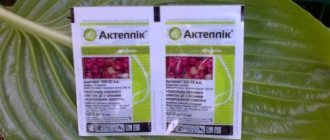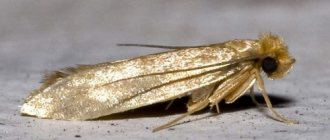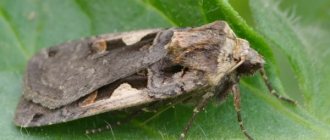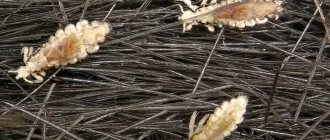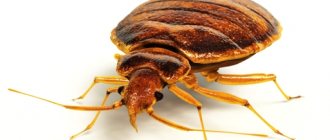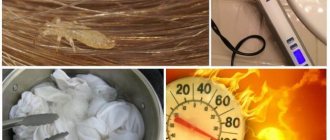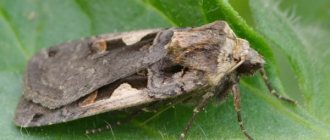The joy of flowering and active growth of your indoor plant can be overshadowed by the appearance of various types of pests, including mealybugs. Flower growers always carefully monitor the condition of their indoor “pets”, and therefore they are interested in one question: how to remove a mealybug when it is detected?
In this article we will talk about poisons for this pest that will save indoor plants from it. But we would like to remind you that at the very beginning of the pest’s reproduction, you can also resort to the help of folk remedies that do not have such powerful destructive properties, but at the same time they have fewer side effects.
Description of the pest
People also call it “furry lice” because of its appearance. They belong to the order of sucking insects . They are very difficult not to notice even with the naked eye. These suckers reach a length of up to 8 millimeters. The body of female scale insects is not fully developed and has an oval shape. But the males are already more similar to the insects we are familiar with: their body is not divided into sections, their limbs are well defined.
As adults, males do not feed because their mouthparts atrophy over time. But females and even larvae can easily make holes in leaves and buds, and then suck the juice out of them. This “function” of the mealybug poses the main danger to a healthy plant.
One of the difficulties in controlling hair lice is that they easily move from one plant to another .
Details about what a mealybug is and how to deal with it are described in this article.
Reasons for appearance
The main reasons are:
- Presence of larvae or eggs in the soil . Moreover, it could even be a substrate from the store. Therefore, it is important to disinfect the soil before planting. To do this, place the soil in the microwave for a few minutes or put it in the freezer overnight.
- Moving mealybugs from a new plant . To prevent this from happening, always quarantine the newly arrived plant in a separate room and monitor its condition for about a month.
- Improper care:
- cold room;
- watering with untreated water or water of the wrong temperature (both too warm and too cold have a bad effect);
- poor ventilation of the room;
- overly active introduction of nutritional complexes.
Infection of the root system with mealybug
There are spots on the leaves on the orchid - what to do?
When a parasite appears in the roots, a rotting process may begin, which will lead to the death of the plant. To rid a flower of insects, you need to:
- Remove the orchid from the pot, clean it of the substrate;
- The product is diluted, according to the instructions, in a container of a suitable size, where the plant is then placed. The processing time must be indicated; if not, then 20 minutes will be enough;
Important! Processing is carried out several times. Between procedures, the plant itself is in a pot (it must be new and clean) without soil.
Popular preparations for indoor plants
"Akarin" (old name - "Agravertin")
It is considered a biological drug. This remedy enters the digestive organs of mealybugs and poisons them. After just eight hours, hairy lice lose their ability to consume food and die 24 hours after treatment .
How to use? To prepare the solution, take one liter of purified water, add two drops of “Akarin” to it (you can do 5, then the concentration will be higher). The sheet plates are wiped on both sides with a cloth soaked in the composition.
It is allowed to apply twice per season, but at the same time maintaining an interval of 15-20 days.
Advantages:
- is not addictive;
- harmless to bird earthworms;
- can be combined with insecticides and pesticides.
Disadvantages: bees can be poisoned by this solution.
Price: 13-20 rubles.
"Aktara"
It acts in much the same way as the previous drug: it enters the digestive system of pests and atrophies all organs .
But it works faster – within half an hour. How to use? You can spray the affected plants (the protective barrier will remain for up to four weeks). For spraying, 1-2 grams of Aktara are poured into ten liters of water. For irrigation (in this case, the protection will last up to 60 days), use 8 grams of the drug for the same amount of water.
Advantages:
- has high efficiency indicators;
- can be used in conjunction with pesticides;
- non-toxic to earthworms and birds.
Flaws:
- causes addiction in scale insects;
- poses a danger to bees.
Price: 25-30 rubles.
"Aktellik"
This drug is chosen only as a last resort, when nothing takes away the hairy lice.
How to use? Dilute the ampoule (its volume is two milliliters) in one liter of water. Spray the plant with the resulting solution. The result is expected three days after the procedure . You can repeat the treatment no more than two or three times. After this, the plant should rest for two to three weeks.
Advantages: powerful drug.
Disadvantages: “Actellik” is a chemical product, so treatment with it can only be carried out outdoors. But even under this condition, pregnant women and people with asthma are prohibited from using the product.
Price: 6-10 rubles.
"Bankol"
This drug paralyzes not only the digestive system, which is why the bugs cannot feed, but also the central nervous system, after which the pests stop moving. After a couple of days, the “lice” die .
How to use? Place 1 gram of the product in two liters of water and spray the plant with the resulting composition. It will be necessary to carry out two such treatments, maintaining an interval of 10-15 days between them.
Advantages:
- high efficiency indicators;
- there is no pungent odor and no negative effect on the mucous membranes of the eyes;
- is not washed away by precipitation if it begins two hours after treatment;
- dissolves well in water.
Disadvantages: toxicity of the drug is present, albeit at a low level.
Price: 10-12 rubles.
"Vertimek"
The drug is of natural origin. It affects the central nervous system of parasites and paralyzes them. Death occurs within three days after treatment .
How to use? Dilute the product according to the instructions on the package. Spray the affected plant with it, then cover it with plastic wrap and leave it like that for 24 hours.
Advantages:
- actively fights parasites even in hard-to-reach places;
- destroys pests in a minimum number of applications;
- does not leave marks on the surface of sheet plates.
Disadvantages: high toxicity for humans (in the scientific community - 2nd class).
Price: for a 250 ml bottle you will have to pay about 2000 rubles.
"Inta-vir"
The product affects insects by paralyzing them, causing spasms and convulsions throughout the body.
After these actions, the “hairy lice” die. How to use? One tablet is dissolved in 5-10 liters of clean water (the volume of liquid depends on the desired concentration). You can spray affected plants to save them and healthy ones to prevent pest attacks. It is important to use the prepared solution immediately . After the mixture sits, it will no longer be suitable for use. The procedure can be repeated no more than three times and at intervals of two weeks.
Advantages: the drug is highly concentrated and fast-acting.
Disadvantages: toxic to humans.
Price: a sachet with 8 grams of the drug costs 10 rubles.
"Karbofos"
How to use?
The drug is sold in various forms: concentrated emulsion, powder, concentrates in ampoules, ready-made diluted drug. The diluted product should be used immediately. The resulting emulsion is sprayed onto the plants. Advantages: The active chemical disintegrates within ten days.
Flaws:
- acrid chemical smell;
- high concentration of chemicals.
Price: the cost of the product depends on its volume:
- 30 grams of powder – about 40 rubles;
- 60 grams of powder - 60 rubles;
- 1000 ml of emulsion – about 150 rubles;
- packaging of ampoules - about 30 rubles.
"Confidor extra"
It acts on parasites in two ways:
- Destroys them by getting on the skin of mealybugs.
- The rest are destroyed when they eat poisoned leaves and flowers.
How to use? One package, weighing one gram, is diluted in 10 liters of water. (This solution is enough to spray a huge number of plants, so try to proportionally reduce the amount of the drug and the volume of liquid). You will see the full result in 48 hours.
Description of the drug (composition, principle of action)
Aktara is an insecticidal drug of chemical origin belonging to the group of neonicotinoids. Externally, it is a water-soluble brownish granule or a transparent yellow liquid without a noticeable odor. Available in bags of different sizes, ampoules, bottles and canisters. Manufacturer: Swiss.
There may be counterfeits of Aktara on sale that do not correspond to the declared characteristics. Before purchasing the drug, you should carefully study the packaging and documentation for the product available from the seller.
The main active ingredient in Aktara is thiamethoxam, a powerful nerve poison that has a destructive effect on pests within several hours after use.
The principle of action of the insecticide is as follows:
- the poison penetrates plant tissue and spreads throughout it along with cell sap;
- the insect, feeding on plant sap, also absorbs the toxic components of the drug;
- the poison causes intestinal upset and paralysis of the internal organs of the insect, as a result of which it stops feeding and dies within 24 hours after contact with the insecticide.
The process of decomposition of the active component takes quite a long time, so the protective effect of Aktara on plants lasts about 3-4 weeks, and if the drug is applied by soil, the effect of its use is noticeable for almost 2 months.
Prevention of insect development
In order to avoid poisoning yourself and plants with chemicals in the future, it is better to prevent the development of harmful insects. To do this you should:
regularly inspect the plant;- replant flowers in time, renew the soil in pots;
- follow all recommendations for the care of each specific flower;
- promptly remove dried parts of the plant;
- disinfect the soil before planting;
- Quarantine new flowers.
We all want our home to have a lot of greenery, and for this greenery to be healthy and blooming. But this requires effort. Today we described in detail how to deal with one of the types of pests (what other types of scale insects are there and how to deal with them?). This information should help you in properly caring for your plant. And for conscientious care, the plants will definitely reward us with clean air in the house.
How to deal with mealybugs on indoor plants?
Pests on indoor plants give us unpleasant emotions. And we want you to be joyful and cheerful - so look at our tips.
Experts recommend comprehensive control of mealybugs on indoor plants. If the flower is slightly damaged, it is not difficult to fight the pest and you can try using folk remedies, but if the damage is severe, it is better to use drugs.
In any case, to get rid of mealybugs you need to carefully follow the recommendations of specialists and experienced gardeners.
COMBAT MEASURES
- Remove affected leaves or shoots when the pest is detected. If trimming is not possible, then remove all the scale insects with a cotton swab dipped in soapy water.
- Move the affected plant to a separate place, and carefully inspect the rest. Wash the area near the affected flower (window sill, window, outer sides of pots) with soapy water and then with insecticide.
- Replace the top layer of substrate.
- Using a cotton swab, cloth or soft toothbrush, wash the plant with a solution of water and methyl alcohol (1:1), soap solution or tobacco infusion to wash away small mealybugs.
- Rinse off the solution and leave the plant to dry. After the water has evaporated from the leaves, spray the plant and top layer of soil with an insecticide or folk remedy.
- Cover the flower with a bag for 20-30 minutes and rinse it in the shower to wash off the drug and the dead mealybug. If you treated it with a systemic insecticide (Aktara, etc.), then there is no need to wash it off.
- In between treating the plant, wash it every day with water and clean it of parasites.
ADVIСE. Types of plants whose leaves cannot be washed must be sprayed, preferably with preparations.
If the root system is damaged by the pest, carefully wash the roots and trim off the damaged areas, and then transplant the plant into a new substrate.
Treating mealybugs is often a fairly long process that can take 6-12 months.
Mealybug remedy
Remedies for mealybugs on indoor plants can be chemical or folk, which have their own advantages and disadvantages. Many experienced gardeners believe that insecticides are a more effective remedy.
In order to get rid of mealybugs, it is necessary to use intestinal rather than contact preparations. According to experts, systemic insecticides work well.
How to determine the presence of parasites
Inspect leaves on both sides and their axils, flowers and buds. The orchid is taken out of the pot, particles of the substrate are carefully removed, and the roots are washed in lukewarm water.
Advice! Sometimes it can be difficult to detect insects in the substrate. They use a trick: place a piece of cucumber or apple on the surface of the soil overnight. The next morning they check whether the parasite crawled onto the treat or not.
The healthy color of the root system is greenish-pearly - before watering, green - after it. The roots are thick, elastic, smooth. If black, brown, brown spots, soft slimy areas, or yellowing are found, it means that the orchid is sick.
The damaged areas are cut off with a sharp sterile instrument, the sections are sprinkled with cinnamon and crushed activated carbon. If signs of pests are detected in the soil, the plant is transplanted into a new substrate.
Popular drugs
We present popular preparations for mealybugs and indicate the hazard (toxicity) class: 4 – low danger to humans, safe for bees and beneficial insects, 3 – moderately dangerous substance, 2 – highly dangerous substance, 1 – extremely dangerous for humans and animals.
We also indicate the active ingredient and approximate prices for the products in Russia.
- “Akarin” (old name “Agravertin”) – 4, (avertin), price: 4 ml package – 13-20 rubles.
- "Aktara" - 3, (thiamethoxam), price: 1.2 ml ampoule - 40-50 rubles, 4 g package - 90-120 rubles.
- "Actellik" - 2, (pirimiphos-methyl), price: 2 ml package - 30-50 rubles. In Russia, the drug for personal use is not registered as of October 1, 2016. Although sometimes the drug can still be found in small stores and on the Internet.
- “Bankol” - 3 (bensultap), price: 10 gram package - 30-40 rubles.
- “Vertimek” - 2, (abamectin), price: 90 dollars/liter, manual packaging - 2 ml - 25 rubles.
- “Inta-Vir” - 3, (cypermethrin), price: 8 g package - 10-15 rubles.
- “Karbofos” (“Malathion”, “Fufanon”) - 3, (malathion), price: 30 g package - 30-40 rubles (strong unpleasant odor).
- “Confidor Extra” - 3, (imidacloprid), price: 1 g package - 30-40 rubles.
- “Tanrek” - 3, (imidacloprid), price: 1 ml ampoule - 10-15 rubles.
- “Fitoverm” - 4, (aversectin C), price: package (ampoule) 4 ml - 15-20 rubles.
- Prices are based on hypermarkets such as “Obi”, “Leroy Merlin” according to the exchange rate of 1 dollar = 65 rubles. These drugs are widely found in many flower shops.
Which drug should I choose?
If the plant is severely infested, getting rid of the mealybug is not easy. You need to try and select an effective insecticide individually so that the pest does not have time to get used to the active substance.
Therefore, look for reliable preparations for mealybugs on indoor plants, which have received positive reviews and recommendations from specialists.
- The Flower Festival magazine recommends starting the fight against mealybugs with the drug Fitoverm, which is as safe as possible for humans and animals, or Aktara, a powerful systemic insecticide.
If these drugs are not found or their effectiveness has decreased, then use Inta-Vir or Tanrek/Confidor. All of these drugs can be alternated if necessary.
And in case of serious damage or weak effects of previous drugs, use “Actellik” or “Karbofos”, “Vertimek” as they are more toxic.
Karbofos, Vertimek and Actellik can only be used to treat indoor plants outdoors.
ATTENTION! Carefully read the instructions for use of any drug and follow the manufacturer's recommendations.
Now you know an effective remedy for mealybugs on indoor flowers, and we will take a closer look at some of them.
"Fitoverm" from mealybug
"Fitoverm" is a popular and effective remedy in the fight against mealybugs. In many situations, it helps well to get rid of pests on indoor plants.
We recommend that flower growers who want to use low-toxic preparations use it first.
"Fitoverm" is an insectoacaricide of biological origin with minimal danger to humans and domestic animals.
- To get rid of mealybugs, dissolve 2 ml of the drug in 200 ml of water and spray the indoor flower. Treatments are carried out every 5-8 days depending on the size and age of the home plant, as well as air temperature.
Composition, rules of breeding and use
The active ingredient “Fitoverma” is aversectin , concentration 2 g/liter. The biological product is produced on the basis of soil microorganisms and is therefore safe.
The orchid is processed on the balcony. Children and pets, as well as other indoor plants and an aquarium with fish should not be in the room. A container should be used that is not subsequently used for food.
Note! Treatment is carried out with a freshly prepared solution. The drug cannot be stored. Effectiveness lasts up to 8 hours in a place protected from light.
During the treatment process you should not eat, drink or smoke. At the end, wash your face and hands thoroughly with soap and water and rinse your throat.
Important! The drug has a hazard class of 3. This means that it is only dangerous if ingested. However, when working, they strictly follow the instructions and use personal protective equipment - a mask and gloves. Contact of the product with the skin and mucous membranes may cause allergies. The drug is stored out of the reach of children and pets.
Preparation depends on the type of parasite being treated:
- Aphids, whiteflies, thrips, duras. Dissolve 2 ml of the drug in a glass of water.
- Spider mites: 2 ml per liter of water.
Note! The temperature of the water used to prepare the solution should be 15-300C.
Before treatment with Fitoverm, insects are mechanically removed from the orchid - with sterile tweezers, a damp swab, or a cotton swab. Next, the plant is given a warm shower, left to drain, and the necessary processing measures are carried out.
Note! The plant is sprayed with the drug. Watering alone cannot be used, since Fitoverm is not a systemic drug, that is, it is not absorbed by the root system.
Spraying
Produced in the morning, with protection from sunlight - the drug quickly decomposes in the light. The leaves are treated - on both sides, the trunk, peduncle and bulbs - as necessary.
Watering
Produced in the morning, if insects were found in the substrate, using the immersion method. Leave for 5-10 minutes, leave to drain and return to its permanent place. Or the orchid is watered with a solution instead of water.
After treatment, the orchid is left without soil for a week, placed in a plastic bag for a day. Then the orchid is placed in a container without soil. Place separately from other plants. The roots are sprayed with water daily. Inspections are carried out periodically. If signs of infection are visible after a week, repeat treatment. If there are no signs, for the purpose of prevention, the orchid is sprayed with Fitoverm.
If leaves are damaged, gardeners recommend wiping the leaves with a cotton pad soaked in the preparation at least 4 times a day for 10 days.
Store the drug in a place inaccessible to children, at a temperature of -20 - +300C, for up to 2 years.
Tick and flea repellent
Flea and tick repellents with the active ingredient imidacloprid (finpronil, cypermethrin) effectively help get rid of mealybugs on indoor plants. For example, drops - “Advantix” (550 rubles), “Avanpost” (250 rubles).
After 1, 2, 3 points from the general instructions.
- Mix the drops with water: a small pipette in 500 ml, and a large pipette in a liter of warm water.
- Moisten the leaves, axils, petioles and stem of the plant, as well as the top layer of the substrate, with this emulsion on both sides.
- After the solution has dried, ventilate the room. The solution does not need to be washed off, and if the odor is strong, it can be washed off every other day with water.
As a rule, one procedure is enough; if necessary, repeat after a week.
If you cannot re-process the plant, then you can cover the pot with the plant with a bag (garbage) and leave a gap. Spray the plant with Bolfo aerosol (400 rubles) for 3-4 seconds, tie the bag and leave the flower for 24 hours - the mealybug will suffocate.
IMPORTANT! Carry out all procedures only in the open air or on the balcony!
- The drugs "Tanrek" and "Confidor" contain a similar active ingredient, so you can safely use them.
Which plants are most often affected and why they are dangerous?
The most dangerous for plants are females and small larvae that feed on the sap of leaves, causing the plant to die. Adult males do not harm plants because... their oral apparatus atrophies. There are several types of parasites. Thus, the citrus bug attacks any citrus crops (lemon, orange, tangerine, lime). The naked eye can see females whose body reaches 4 mm and is covered with a white fluffy coating.
photo of mealybug on indoor plants
Grapes suffer from grape bugs, and the bristly bug affects the following house plants:
- succulents;
- dieffenbachia;
- dracaena;
- cactus;
- orchids;
- fuchsia;
- violet;
- azaleas;
- palm;
- monstera;
- Kalanchoe;
- asparagus.
If the leaves of a plant curl and turn white, the shoots become deformed and dry out, a noticeable white coating, similar to pieces of cotton wool, appears on the leaves, buds and stems. And in the roots (during transplantation) multiple whitish threads are clearly visible.
How to get rid of mealybugs using folk remedies?
Experts have different views on folk remedies in the fight against mealybugs. Many gardeners complain that folk remedies are extremely ineffective and, moreover, can harm the plant.
The editors of the Flower Festival magazine believe that folk remedies for mealybugs can be used in certain situations, since they are safer for humans and animals.
If the degree of damage to the flower is small and there are not many pests, then it is better to start treatment with folk remedies. And also if this is a plant that can be sacrificed, but there is no desire to buy insecticides because of it.
In any case, the use of folk remedies for mealybugs on indoor plants is the personal choice of each gardener, but systemic insecticides are more effective.
1. Soap solution
To prepare a soap solution, household, tar or green potassium soap is suitable, and, in extreme cases, dishwashing detergent is suitable.
It is necessary to treat the entire house plant with a soap solution, as well as the window sill, window frame, pot and pot tray. The more foam in the process, the better.
After wiping the flower, it is better to wash off the soap suds after 2-4 hours.
RECIPE. Pour a tablespoon of soap shavings into a glass of warm water. To enhance the effect, you can add a teaspoon of ammonia (technical, medical, or, in extreme cases, vodka) and 300 grams of water.
The soap-alcohol solution must be washed off after 10-15 minutes with warm water so as not to burn your home flower.
IMPORTANT! Some experts insist that using soap solution on indoor flowers is not permissible. In their opinion, soap blocks the stomata of the plant, which leads to disruption of photosynthesis and plant development.
Plants with delicate leaves should not be treated with alcohol.
2. Garlic
Garlic infusion is a popular folk remedy in the fight against various pests.
Pour a glass of water over five crushed cloves (a teaspoon of pulp) of garlic. Infuse the mixture in a tightly sealed container for 1-2 days, and then wash the plant every 7-8 days. To spray, strain the infusion through three layers of gauze.
Recipe No. 2. A teaspoon of garlic pulp (4-5 cloves crushed) is poured into 500 ml of boiling water and left for 4-5 hours. The infusion is filtered and the affected flower is wiped.
3. Onion
A medium-sized onion is finely chopped, mashed and poured with a glass of water for 2-3 hours. Then everything is the same as with garlic.
ONION PEEKS. To prepare the infusion, pour 20 grams of husk with a liter of warm water and leave for 13-16 hours. The resulting infusion is sprayed on indoor flowers; usually 2-3 procedures are enough to remove aphids.
4. Pepper infusion
Infusion of red hot pepper: boil 20-30 grams of crushed (finely chopped) pepper in 200 ml of water for 60 minutes. Then leave the resulting liquid for 24 hours and strain. To spray, dilute 10 ml of infusion in a liter of water.
You can treat plants with pepper infusion once every two weeks. Pepper tincture can be stored for a long time in its finished form, which allows it to be used very quickly.
5. Oil
Beat 5-10 grams of soap in a glass of water until foam appears, add 15-20 ml of machine oil (2 tablespoons of olive or sunflower). The plant is washed completely with a soap-oil emulsion and left for 6-10 hours, and then washed off.
Carry out 2-3 procedures every 7-10 days. Before treating the plant, cover the soil mixture in the pot with film! Treatment with a water-oil emulsion is not recommended for plants with pubescent, delicate or very thin leaves.
Pest prevention
Proper care of your orchid will protect it from pests. Rules :
- Optimal watering. Is individual for each plant. An indicator that it is time to water the plant is the silvery color of the roots. A useful technique is used: a wooden stick is placed in the soil. If it is dry when removed from the substrate, the orchid is watered. If there are midges in the soil, the plant is watered.
- When purchasing a new orchid, place it separately from other indoor plants for a month. If no signs of diseases or pests are found, the pot is moved to the right place.
Advice! For preventive purposes, the newly acquired plant is watered and sprayed with Fitoverm. Take 2 ml of the drug per 1 liter of water. Next, the orchid is left in a draft-free room. After an hour, the leaf axils are wiped with a dry cloth.
- Leaves, buds, flowers, roots are periodically inspected. If signs of insects are detected, the orchid is isolated and treatment begins.
- The air around the orchid must be humidified. Thrips like dry environments.
- Scale insects like excess nitrogen in the soil and settle on weakened plants. Fertilize the plant only when necessary, following the instructions.
- When making soil yourself, its elements are calcined in the oven at 1500C for 5-10 minutes and boiled. You can buy a ready-made substrate or its elements at a flower shop.
- The orchid pot is chosen to be transparent, with smooth walls. This way the gardener will be able to observe the roots, notice the presence of diseases or pests in time and begin treatment.
Pest prevention at home
The best remedy for mealybugs on houseplants is to regularly inspect your pets: especially carefully inspect the leaf axils, stem, and the inside and outside of the leaves.
At home, the pest is suppressed by ventilating the room, spraying and washing the leaves of plants, since the mealybug loves dry air and is afraid of moisture.
Avoid the situations described in the “Where Mealybugs Come From” section of the companion article.
ADDENDUM TO THE ARTICLE:
The review of the pest has come to an end. We hope that now you can fight mealybugs on indoor plants using drugs (insecticides) or folk remedies more effectively.
And the main thing is to be able to get rid of mealybugs and enjoy your favorite plants!
Mealybugs, which attack indoor and greenhouse flowers, as well as berry plants and fruit trees, are the main problem for many flower growers and gardeners. This flower vampire literally sucks all the life force out of plants. They are stunted in growth, covered with a white cobwebby coating and quickly fade. Meanwhile, the colony of pests grows and moves from a dying flower or bush to a neighboring, completely healthy one.
How to stop the army of these voracious invaders? Folk remedies are used quite effectively to destroy scale insects. And insecticides are resorted to only in case of a large number of pests or the ineffectiveness of the previous method.
Where do mealybugs come from?
Mealybugs are small insects a few millimeters long. They have a soft, segmented body covered in a white or pinkish covering that resembles wool or cotton.
May enter through windows and ventilation networks. Get on plants that are placed on balconies and terraces in summer. You can bring them home when you buy exotic plants.
Most of the time they remain inactive - skillfully hiding in the corners of leaves, in flower buds or in the soil. When external conditions become favorable for them - air humidity decreases and temperature rises - they begin to feed. This is why mealybugs usually appear on orchids in winter during the heating season.
Outdoors, the mealybug is active from spring to early autumn, when climatic conditions are suitable for its growth. Therefore, it is very important to treat orchids and other flowers located outside, in open ground, at this time of year to avoid infection.
Popular means of struggle
If there are a lot of pests, it is better to immediately resort to drastic measures - insect killers known on the market. Timely treatment with insecticides will save the flowers and save the nerves of the owners.
All work with chemicals is carried out only with rubber gloves and a respirator!
Aktara
"Aktara" is a complex drug used to control many pests.
The insecticide solution is applied to the diseased plant using a spray bottle or poured into the soil at the base of the stem. Spraying provides protection for up to four weeks. The active substance lingers in the soil a little longer, up to two months. When sprayed insecticide
acts in 20–30 minutes, reducing appetite and causing disruption of the digestive system.
To prepare a solution, take 1-2 g (for spraying) or 8 g of the drug (for watering) per 10 liters of water. This ratio is used when working with indoor plants.
When processing vegetable and garden crops, milk is first prepared (1 packet of product per 1.5 liters of water). To spray currants you need 250, and to treat flower beds 600 milliliters of milk.
- effective in most cases;
- compatibility with pesticides;
- low toxicity to earthworms and birds.
- addictive to pests;
- toxic to bees.
Aktofit
"Aktofit" contains a natural toxin that is dangerous for many types of garden and garden pests, including scale insects.
The active substance affects the nervous system, causing paralysis. The death of sucking insects occurs eight hours after spraying.
Processing is carried out at temperatures above +18 degrees. Optimal temperature indicators are +28 degrees. To obtain a solution, 4–12 milliliters of the drug are dissolved in a liter of water.
- does not pollute the soil;
- is not addictive;
- compatible with fertilizers and other insecticides;
- One or two treatments are enough.
- the drug is not effective at temperatures below +18 degrees;
- dangerous for bees.
Akarin
"Akarin" belongs to the group of biological drugs.
After spraying, the active substance penetrates the digestive system of pests, causing acute poisoning. After just eight hours, the mealybugs lose activity and stop feeding. Pests die on the second day after treatment.
To prepare a solution, 2 or 5 milliliters of the product are diluted in a liter of water. Plant leaves are wetted on both sides. The insecticide can be used several times a season, with an interval of 2-3 weeks.
- is not addictive;
- non-toxic to earthworms and birds;
- compatible with pesticides and other insecticides;
- used at temperatures from +12 degrees and above.
Disadvantages: dangerous for bees.
Fitoverm
“Fitoverm” is a preparation created on the basis of waste products of soil microorganisms.
Sucking pests lose activity sixteen hours after treatment and die on the second day.
The active substance affects the digestive system of insects, reducing appetite and causing acute poisoning. The effect of the drug is from one to three weeks.
To obtain a solution, 4 milliliters of insecticide are mixed with two liters of water, and then the resulting mixture is diluted to the required volume. It takes 100–500 milliliters of solution to treat a medium-sized indoor plant. In greenhouses and outdoor flower beds, the consumption is 10 liters per 100 square meters of area. Treatment can be carried out at intervals of two weeks.
- does not pollute the soil;
- completely breaks down into safe elements in the soil;
- Compatible with fertilizers and growth regulators.
- not effective in rainy weather;
- dangerous for bees.
Mospilan
"Mospilan" is a contact drug used to combat many types of insect pests.
Penetrates into plant sap, so it is effective even on untreated areas of stems and foliage. Affects all ages of pests: eggs, larvae and adults. The active substance, entering the digestive system of an insect, causes paralysis. An hour after treatment, insects lose activity and die on the second day. The protective effect lasts two to three weeks.
To obtain a solution, 2.5–5 grams of the drug are stirred in a liter of water. Then the resulting milk is diluted in a bucket of water (10 l). This amount of solution is enough to treat an area of 250 square meters.
- non-toxic to plants;
- compatible with fertilizers and other preparations.
- not effective at low temperatures;
- toxic to bees.
Fufanon
"Fufanon" is a complex action drug used against many insects.
Affects the nervous system of pests, causing death within two to three days. Emulsion concentrate in an amount of 10 milliliters is mixed in 10 liters of water. Two or three treatments per season are allowed. The interval between spraying is three weeks. If vegetables have been processed, they should not be eaten for 20 days.
- non-toxic to plants;
- effective at temperatures above +12 degrees.
- toxic to bees and fish;
- does not mix with other drugs.
Phytoseiulus is a predatory mite that feeds on pest eggs. Read more about this beneficial insect in the article.
“Sunmite” is a popular drug that is designed to combat ticks that feed on agricultural crops. You will find detailed information about this acaricide at https://stopvreditel.ru/rastenij/borba/akaricidy/sanmajt.html link.
What is it and what is it used for
Concentrated emulsion, has a wide spectrum of action, used to combat ticks and insects. Sold in packages of 2 and 4 ml (glass or plastic ampoule), 20 and 50 ml (bottle), 5 l (canister). Has a strong chemical smell. The color of the emulsion is yellowish. Effective against:
- ticks,
- aphids,
- caterpillars,
- thrips,
- scale insects,
- whiteflies,
- Podurov,
- leaf roller,
- Colorado potato beetle,
- paths,
- worms.
Mechanisms of action:
- Contact . The insect dies from contact of its surface with the product after 3-5 days.
- Intestinal . The toxic substance penetrates the parasite’s stomach, and after 10 hours paralysis of the digestive system occurs. As a result, the insect dies.
The effect after treatment lasts up to 14 days. Thus, if the procedure is carried out twice, the orchid will be protected for a month.
Advice! If a plant is heavily infested with scale insects or mealybugs, the best result will be obtained not by Fitoverm, but by a systemic chemical insecticide.
Insects that gnaw on parts of the orchid will die within 2-3 days. The sucking pests will die in 5-6 days.
Folk remedies: soap-alcohol solution
A soap-alcohol solution is a frequently used folk remedy to combat mealybugs.
A teaspoon of crushed laundry soap is dissolved in water, then the amount of solution is increased to a liter. Add a tablespoon of alcohol or two tablespoons of vodka.
The plant is sprayed, while the soil underneath is protected with film or a piece of cellophane.
The next day, the soap must be washed off with clean water. Treatments are carried out at intervals of three days until the scale insects completely disappear.
Advantages:
- cheapness;
- effectiveness in case of minor plant infestation by pests;
- safety for humans and animals.
- the product does not help with large numbers of scale insects;
- Frequent processing required;
- inconvenient to use on outdoor plants (due to the size of the latter or the threat of rain).
Advantages and disadvantages
Before using Aktar against pests that pose a danger to orchids, you should carefully study the positive and negative characteristics of the insecticide. They are as follows.
Advantages:
- high efficiency against a wide range of dangerous insects;
- minimal phytotoxicity;
- resistance of the active component of the drug to elevated air temperatures;
- ensuring a long-term protective effect;
- ability to quickly penetrate plant tissues;
- efficiency and affordable price.

